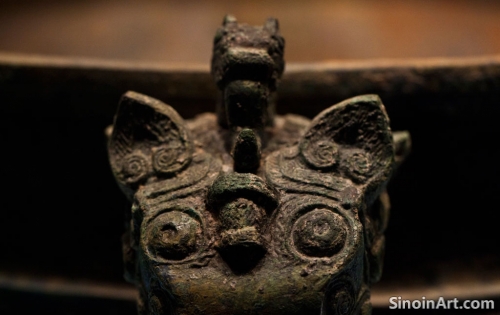The Development of Bronze in the Spring and Autumn Period: New Forms, Techniques, and Regional Styles
|
The Spring and Autumn period (771-476 BCE) in China witnessed significant changes in the production and style of bronze ware, as regional kingdoms emerged and developed their own unique artistic traditions. This period saw a move away from the more uniform designs of earlier periods to a richer, more varied approach to the metalworking arts. The fragmentation of the political landscape helped to lead to a greater degree of artistic experimentation.  Bronze objects from the Spring and Autumn period often featured new forms, decorative patterns, and innovative casting techniques. The artistic traditions of the period demonstrate a growing degree of technical expertise and also a clear desire to experiment with new and different forms and designs.  Regional variations in bronze ware became more pronounced during this period, with kingdoms like Chu, Wu, and Yue, developing their own distinct approaches to bronze production, blending aspects of the Central Plains style with their own unique artistic sensibilities. The interplay of local styles and Central Plains styles helped to shape the unique and varied character of this era.  The rise of trade and cultural exchange also played a role in shaping bronze designs, with foreign influences, particularly from neighboring nomadic tribes, becoming more readily apparent in some regional styles. The cross-cultural interplay helped to enhance the variety and interest of the metal works of the era. The study of bronze ware from the Spring and Autumn period reveals the increasing artistic freedom and experimentation that took place during this time, as well as the unique styles that were developing throughout ancient China. The diversity of the bronze work helps to paint a clearer picture of the complex history and culture of the time. |
Tag : Spring and Autumn bronzes, regional styles, Chinese metalworking, ancient innovation, bronze evolution
Related information
- The Influence of Ancient Chinese Bronze Ware on Later Japanese Art and Design
- The Use of Bronze in Ancient Chinese Military Armor: Protection and Power on the Battlefield
- Analyzing the Surface Patina of Chinese Bronze Ware: A Story of Time and Environment
- Bronze Ware and the Representation of Authority: Imperial Symbols and Power
- Bronze Ware and the Ancient Chinese Elite: Luxury, Status, and Power
This article explores the influence of ancient Chinese bronze ware on later Japanese art and design, highlighting the adoption of Chinese forms and techniques, the development of unique Japanese styles, and the impact of cultural exchange on creative expression.
This article explores the use of bronze in ancient Chinese military armor, highlighting the types of helmets and armor plating, and how bronze was used to provide both protection and power on the battlefield.
This article explores the surface patina of Chinese bronze ware, discussing its formation, its value as a historical record, the factors that influence its appearance, and the techniques used to distinguish between natural and artificial patinas.
This article explores the representation of authority in Chinese bronze ware, highlighting the use of symbols, emblems, weapons, and other objects to demonstrate imperial and elite power, and the connections between material culture, political ideology, and the assertion of control.
This article explores the association of bronze ware with the ancient Chinese elite, highlighting its use as a symbol of wealth, status, power, and its role in reinforcing social hierarchies and displaying authority.